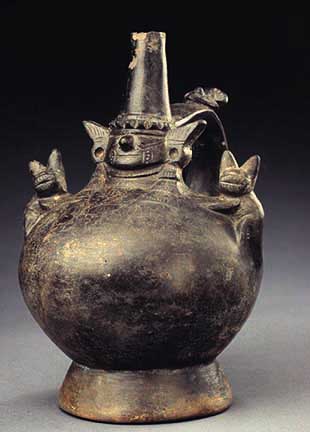|
The Sicán culture also known as the Lambayeque culture reigned in the years 700-1375 A.D. in the northern parts of Peru´s north coast. The culture developed largely on the basis of the Moche culture, but the Moche features were mixed with influences from the Wari culture and from the mountain area in the north, the result of which was a syncretistic Sicán art.
Metallurgy was unquestionably important for the art forms of the Sicán culture. Utensils made from bronze-like arsenic copper were common
as also decorative tumi knives, funeral masks, goblets and ear rings. Metal was not used only to adorn people but also to decorate textiles, ceramics, wooden objects, tombs and important buildings.
The most typical Sicán vessel has been made with the help of complex two-piece moulds and decorated by a trowel-like tool with impressions made on wet clay. Ceramics is mainly of one colour, but also paint-decorated and sculptural vessels connected with the Moche tradition were made.
|
|

A vessel with a round chamber decorated with the image of the so-called Sicán Lord and a pair of felines on the top and the spout. The Sicán Lord, a very central motif in the Sicán culture, may present the mythical founder figure of the culture.
© Museo Nacional de Arqueología, Antropología e Historia del Perú -
Instituto Nacional de Cultura del Perú, Lima, Peru (Cat. 195)
|

